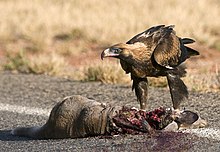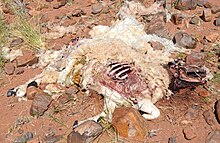Carrion

Carrion (from Latin caro, meaning "meat") is the decaying flesh of dead animals, including human flesh.
Overview
Carrion is an important food source for large carnivores and omnivores in most ecosystems. Examples of carrion-eaters (or scavengers) include vultures, condors, hawks, eagles,[1] hyenas,[2] Virginia opossum,[3] Tasmanian devils,[4] coyotes[5] and Komodo dragons. Many invertebrates, such as the carrion and burying beetles,[6] as well as maggots of calliphorid flies (such as one of the most important species in Calliphora vomitoria) and flesh-flies, also eat carrion, playing an important role in recycling nitrogen and carbon in animal remains. [7]

Carrion begins to decay at the moment of the animal's death, and it will increasingly attract insects and breed bacteria. Not long after the animal has died, its body will begin to exude a foul odor caused by the presence of bacteria and the emission of cadaverine and putrescine.
Some plants and fungi smell like decomposing carrion and attract insects that aid in reproduction. Plants that exhibit this behavior are known as carrion flowers. Stinkhorn mushrooms are examples of fungi with this characteristic.

Sometimes carrion is used to describe an infected carcass that is diseased and should not be touched. An example of carrion being used to describe dead and rotting bodies in literature may be found in William Shakespeare's play Julius Caesar (III.i):[8]
Cry 'Havoc,' and let slip the dogs of war;
That this foul deed shall smell above the earth
With carrion men, groaning for burial.
Another example can be found in Daniel Defoe's Robinson Crusoe when the title character kills an unknown bird for food but finds "its flesh was carrion, and fit for nothing".
In Noahide law
The thirty-count laws of Ulla (Talmudist) include the prohibition of humans consuming carrion.[9] This count is in addition to the standard seven law count and has been recently[when?] published from the Judeo-Arabic writing of Shmuel ben Hophni Gaon after having been lost for centuries.[10]
References
- ^ Hovenden, Frank. The Carrion Eaters Archived 1 June 2010 at the Wayback Machine. Comox Valley Naturalists Society. 7 May 2010.
- ^ "San Diego Zoo's Animal Bytes: Striped hyena". San Diego Zoo. 7 May 2010.
- ^ Len McDougall (2004). The Encyclopedia of Tracks and Scats: A Comprehensive Guide to the Trackable Animals of the United States and Canada. Globe Pequot. pp. 274–. ISBN 978-1-59228-070-4. Retrieved 27 November 2011.
- ^ "San Diego Zoo's Animal Bytes: Tasmanian Devil". San Diego Zoo. 7 May 2010.
- ^ Stegemann, Eileen. "Skull Science: Coyote". NYS Department of Environmental Conservation April 2006
- ^ John George Wood (1892). Insects abroad: Being a popular account of foreign insects; their structure, habits and transformations. Longmans. pp. 82–. Retrieved 27 November 2011.
- ^ Ames, C.; Turner, B. (2003). "Low temperature episodes in development of blowflies: implications for postmortem interval estimation". Medical and Veterinary Entomology. 17 (2): 178–186. doi:10.1046/j.1365-2915.2003.00421.x. ISSN 1365-2915. PMID 12823835. S2CID 10805033.
- ^ The Life and Death of Julius Caesar. SCENE I. Rome. Before the Capitol; the Senate sitting above.
- ^ Talmud, Hullin 92b
- ^ Mossad HaRav Kook edition of Gaon's commentary to Genesis.
